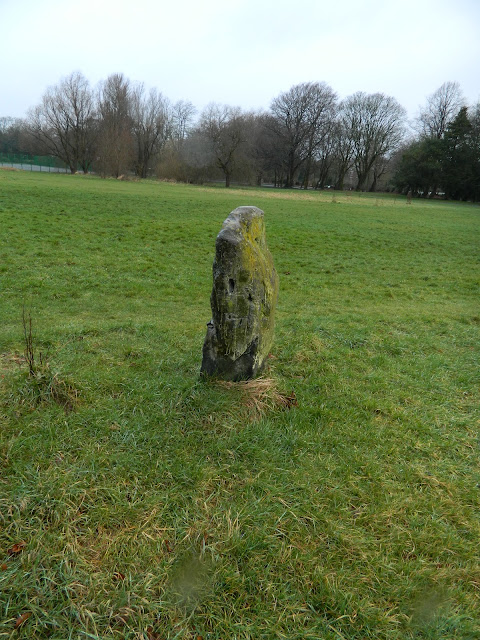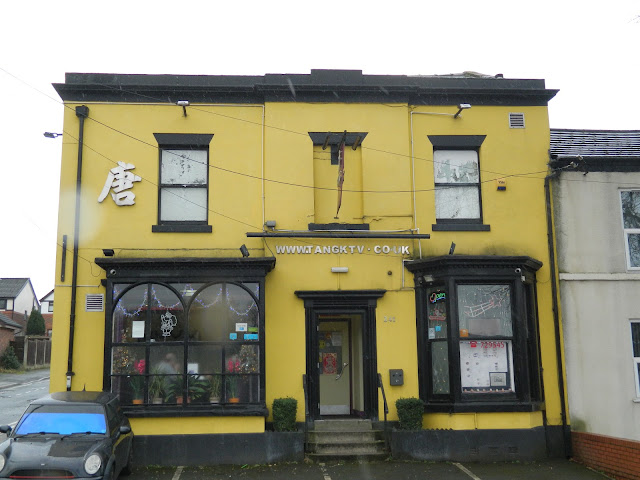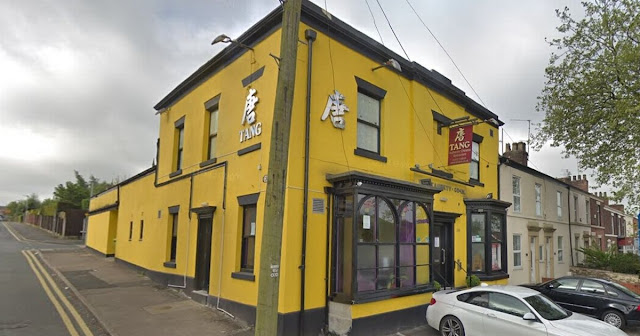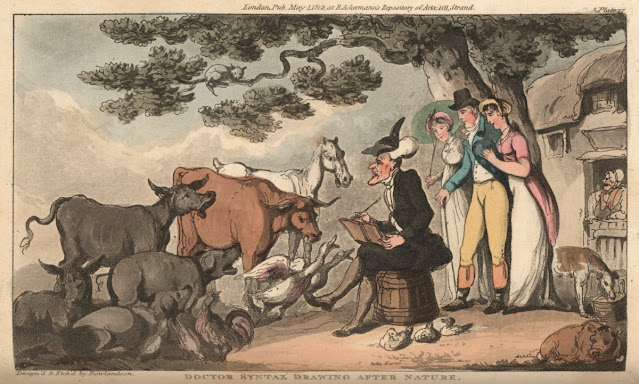Doctor Syntax
A Pub named after a horse that was named after a cartoon character
Penwortham Holme is an area that many local people will associate with recreation, whether it be football or horticulture. However, in earlier times, there was a completely different form of entertainment happening.
 |
| Penwortham Holme Pavilion |
The following is some history relating to Horse Racing that took place on Penwortham Holme before the new bridge, built in 1912, effectively cut the area in half. The 1912 bridge was built because the earlier bridge further upstream, built in 1759, could no longer cope with the volume of traffic.
The River Ribble in this area is very different now, compared to how it was in the eighteenth and nineteenth centuries. Some of the changes were related to the creation of Preston Docks in 1892. However, at that point there was still an island formed by a narrow water course that was once a larger channel of the River Ribble. The area Penwortham Holme gets its name from the Middle English word holme, which is derived from Old English holm (“wave, ocean, water, sea, islet”) and Old Norse holmr, holmi (“islet” - a small island).
My initial thoughts, following a discovery of the Race Course in Penwortham on a mid-nineteenth century Ordnance Survey map of the area, led me to think that the famous horse had been running around the Holme. Alas, looking at the information available, this was not the case. Further research eventually took me away from Penwortham, toward the north of Preston.
Nevertheless, learning that horse racing once happened in Penwortham after living in the area for over half a century was still very interesting to me.
The Doctor Syntax race horse
Doctor Syntax was a famous British thoroughbred racehorse born in 1811. Doctor Syntax was a bay or brown horse standing 15 hands high. Trained in Yorkshire, and racing exclusively in the North of England, Doctor Syntax was noted for his consistency and durability, winning at least thirty-six races from 1814-1823. He won the Preston Gold Cup on a record seven consecutive occasions.
Doctor Syntax: A black horse in profile to right with a short tail and thick, straight mane, standing in a field with clumps of bracken and ferns to right, a lake in the middle distance and mountains along the horizon; proof. 1823
Crayon lithograph on chine collé
Print made by: James Ward
Published by: Ackermann
 |
| Doctor Syntax | Print made by: James Ward | Published by: Ackermann |
 |
| Doctor Syntax | Print made by: James Ward | Published by: Ackermann |
Up until the construction of the bridge over the River Ribble at the bottom of Fishergate Hill, linking the west of Preston to Penwortham, there was a race course on "The Holme".
Prior to that there were two other Horse Racing Courses around the town. Initially events took place at Preston Moor, which then became Moor Park, and then later Fulwood Moor.
Preston first staged racing as early as Thursday 6th July 1727 on Preston Moor. There is a stone that can be seen on Moor Park, which is said to indicate the start line of the original course (see images below). The stone is known as ‘The Starting Chair’.
 |
| Map Showing the Preston Moor Race Course and the Starting Chair |
Horse Racing moved north from Preston Moor to Fulwood Moor. However, this wasn't a consequence of the creation of Moor Park. In the 1830s the town's council felt that Preston Moor was in a 'neglected and unprofitable condition'. In 1833, a local newspaper (The Preston Chronicle) published an article on 'The Intended Inclosure and Improvement of Preston Moor'.
That would suggest that Preston Moor's condition of neglect, was not related to movement of the course to a location further north. The racing had already moved to Fulwood at that point and then stopped for about a decade.
 |
| A Map of the North of Preston showing the Fulwood Moor Race Corse |
After Preston Moor, racing moved to Fulwood Moor from 1786 to 1833. Following a 9 year hiatus, racing continued in the Preston area, between 1842 and 1850, but now on ‘The Holme’. The racecourse features on the first Ordnance Survey maps of the area made around that time.
 |
| Map from Ordnance Survey Town Plans of England and Wales, Surveyed 1847, Published 1849 (NLS). |
As far as I am aware, only one thing remains from Preston's horse racing days. This is a stone that can still be seen on Moor Park, which is said to indicate the start line of the original course. The stone is known as ‘The Starting Chair’.
 |
| ‘The Starting Chair’, Moor Park |
 |
| ‘The Starting Chair’, Moor Park |
Doctor Syntax’s record at Preston. The Preston Gold Cup was won by Doctor Syntax, owned by Mr Riddell on the following dates:
- Wednesday 12th July 1815
- Wednesday 10th July 1816
- Wednesday 9th July 1817
- Wednesday 15th July 1818
- Wednesday 7th July 1819
- Wednesday 12th July 1820
- Wednesday 11th July 1821
Doctor Syntax first won in Preston as a 4 year old and last won in Preston as a 10 year old. This means that Doctor Syntax won his races on Fulwood Moor and not Penwortham Holme, as I’d originally speculated.
In 2014 archaeologists discovered what they believed to be the skeleton of the legendary 19th century stallion Doctor Syntax. The remains were found during excavations at the former royal stables of Palace House, one of the homes of King Charles II, in Newmarket, Suffolk.
 |
| The remains of Doctor Syntax, discovered in 2014 |
The Doctor Syntax pub
The town of Preston once had a Public House named after the famous horse. It can be seen on early Ordnance Survey Maps created (published) in 1849 from surveys carried out from 1844 to 1847.
 |
| The Doctor Syntax Inn public house on Fylde Road |
The Doctor Syntax Inn public house on Fylde Road, Preston is now a Chinese restaurant called Tang (since 2008).
 |
| The Doctor Syntax Public House in Preston |
 |
| The Doctor Syntax Public House in Preston |
 |
| Tang Chinese Contemporary Restaurant, Preston |
 |
| Tang Chinese Contemporary Restaurant, Preston |
Whilst Preston no longer has its Doctor Syntax Pub, there are a few others in various locations around the world. These include Prudhoe in Northumberland, New Ridley in Stocksfield and Sandy Bay in Tasmania.
The Dr Syntax cartoon character
It is generally agreed that Dr Syntax (Doctor Syntax), created by the artist Thomas Rowlandson and the writer William Combe in 1809, was the world’s first cartoon character. The famous horse that won races in Preston took its name from the cartoon character.
 |
| Doctor Syntax, sketching the lake (1812) | Thomas Rowlandson (1757 - 1827) |
 |
| Doctor Syntax, Drawing after Nature (1813) | Thomas Rowlandson (1757–1827) |
Image extracted from page 166 of The Tour of Doctor Syntax: in search of the picturesque ... Fifth edition, with new plates., by William Combe. Original held and digitised by the British Library. The colours, contrast and appearance of these illustrations are unlikely to be true to life. They are derived from scanned images that have been enhanced for machine interpretation and have been altered from their originals. Copied from Flickr.
The tour of Doctor Syntax in search of the picturesque, a poem by William Combe, with hand-coloured plates from etchings by Thomas Rowlandson.
The Tour of Dr. Syntax in Search of the Picturesque is a story of a fictional, rural schoolmaster and pastor who attempts to make his fortune by going travelling, and then writing and illustrating a book about his experiences of quaint and unusual places.
The story is told in the form of verse, written by William Combe, a prolific English writer of miscellaneous prose and satirical verse, and illustrated with colour plates by Thomas Rowlandson. Combe wrote the text to elucidate the illustrations.
It was first published in 1809 in serial form in Rudolph Ackermann's The Poetical magazine as The schoolmaster's tour. The work was first collected into book form 'by popular demand' in 1812, and was reprinted a number of times during the following decades.
This collaboration of designer, author, and publisher went on to produce a further two 'Tours': The Second Tour of Dr. Syntax in Search of Consolation (1820), and The Third Tour of Dr. Syntax in Search of a Wife (1821).
Thanks to John Slusar for the info. that I gleaned from his website: http://www.greyhoundderby.com/Preston%20Racecourse.html
Maps reproduced with the permission of the National Library of Scotland (NLS):
https://maps.nls.uk/view/102343946
Information about 'The Tour of Doctor Syntax, in search of the picturesque' from the RA website (Royal Academy of Arts):
https://www.royalacademy.org.uk/art-artists/book/the-tour-of-doctor-syntax-in-search-of-the-picturesque-a-poem
---------------------------------------------------------------------------



Comments
Post a Comment